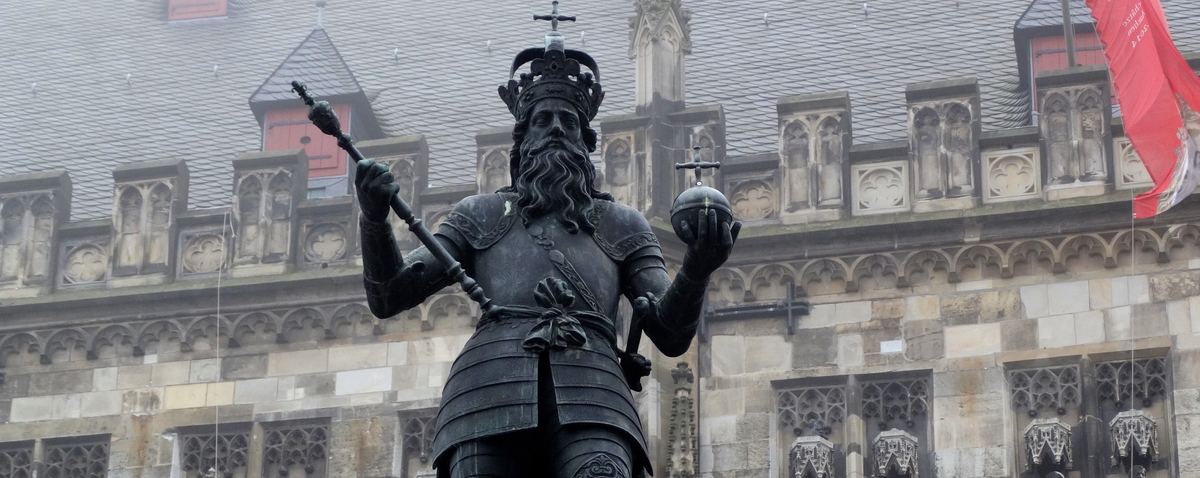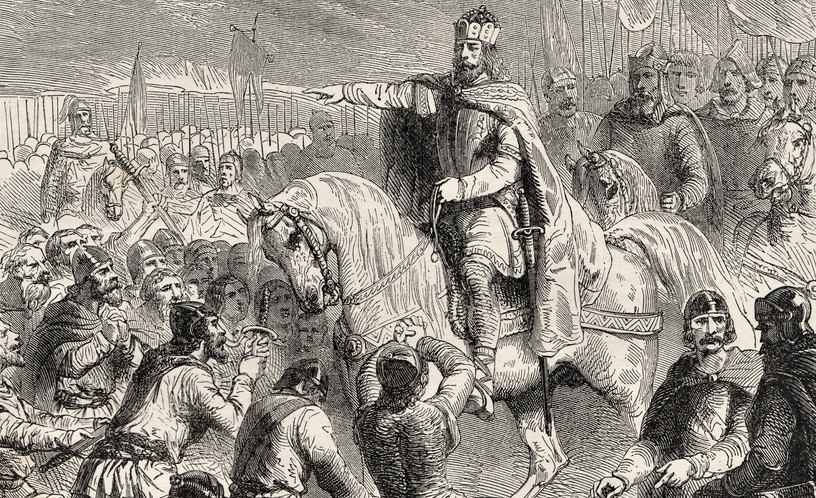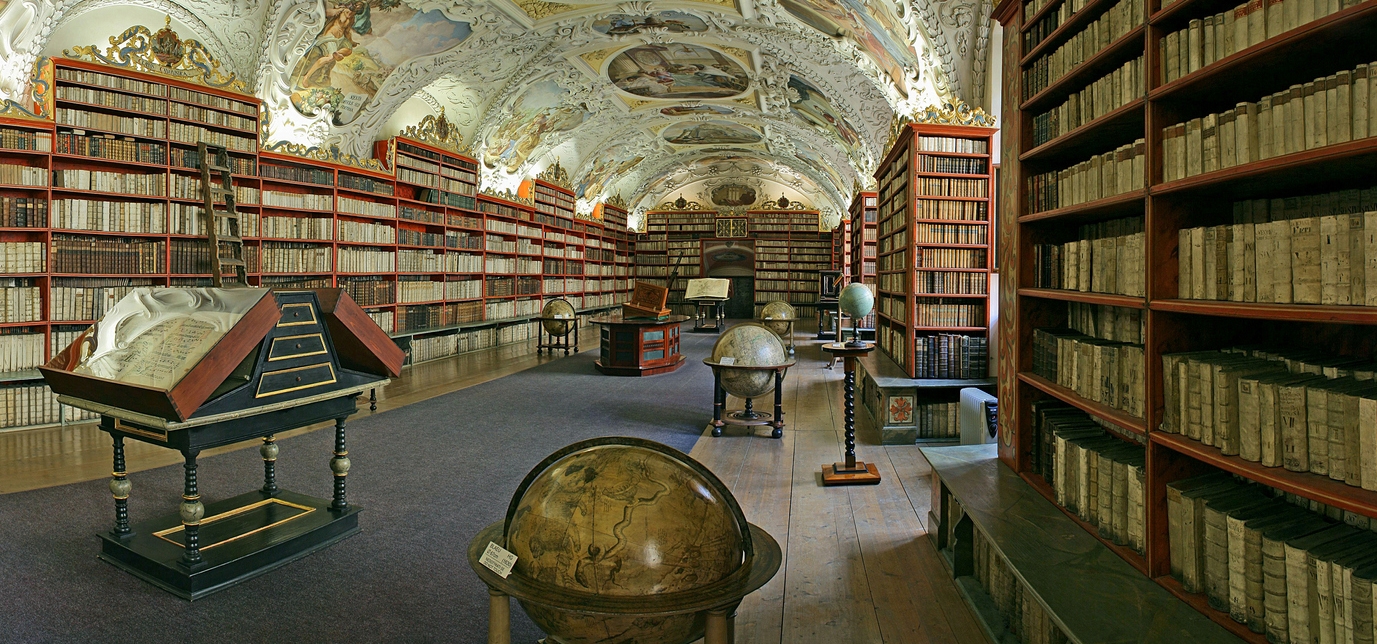Background
Charlemagne or Charles the Great (c.747–814), is one of the most well-known and well-loved influential rulers of the Early Middle Ages. He launched several military campaigns across Europe. One of the well-known ones started in Saxony, Germany, which spread to northern Italy and northern Spain. This was known as the Carolingian empire. When Pope Leo III declared Charlemagne as successor to Rome, this territory was later called the Holy Roman Empire. He ruled for 46 years. [1]
Who was Charlemagne?
Charlemagne is the eldest of the two sons of Pepin the Short (r. 751-768) the first king of the Carolingian Dynasty and Berthrada. He is said to be been born in 747 or 748 in Aachen in the northern part of Germany and west of the Rhine during the last years of the Merovingian Dynasty.
Einhard, a close friend and confidant, describes him as “large, robust, well-spoken, and charismatic individual who was exceedingly fond of all his family, friendly to “foreigners,” lively, athletic (even playful at times), and strong-willed.” [2] He was also described to be taller than the average male at around 5 feet 10 inches to 6 feet 4 inches. [3]
When his father, Pepin the short died, the kingdom was divided into two equal parts according to the gavelkind tradition. At the age of 26, he co-ruled the kingdom with his brother Carloman I (r. 768-771). [4] Carloman was given the eastern part of Pepin’s lands which was more peaceful while the less settled outlying areas of Frankland was managed by Charlemagne. They were complete opposites when it comes to leadership. Charlemagne had great military skill and was decisive while Carloman
In 771, upon Carloman I’s death, Charlemagne became the sole ruler of the kingdom. It was then that the kingdom saw rapid expansion. He saw himself as the head of the Western Church and led military campaigns to convert new territories to Christianity. This lead to relative peace for approximately 46 years of his reign. [2]
He was married five times and had a large brood. He died from pleurisy at the age of 72 on January 2, 814 and the whole of Europe considered it a tragedy.
What made Charlemagne the “Greatest Playwright”?
- He helped unite Europe through the Christian religion. Charlemagne’s conquest brought together most of Western Europe since the Roman Empire. The conquered subjects of Charlemagne had to convert to Christianity. They supported missionary efforts such as recruitment and training of clergies to administer to the spiritual counsel of new converts. In his reign, the kingship took on the role of priest and king similar to the kingship model in the Old Testament and from St. Augustine’s City of God. [5]
- He brought strategic administration reforms in the government and the church. Charlemagne continued to implement the feudal system wherein counts were delegated authority in behalf of the king over specific territories. A scabini or man learned in the law was assigned to each local court. Bishops also helped in the administration of justice, caring for the poor, and the delinquents. Meanwhile, the central government or palatium was composed of both the lay and ecclesiastical entourage of the king. Missi Dominici or royal agents were also employed to supervise the officials spread out in the territory. He also introduced the hierarchal church organization wherein the responsibilities of individuals were clearly defined. He also initiated streamlining the Orthodox doctrine. [6] He supported diversity and inclusivity. Through his conquest, different ethnic groups was brought together as one nation. Although capitularies were issued as a blanket law that included everyone regardless of ethnicity, they were still allowed to retain their own local laws. They were written down and enforced with respect. Local traditions and customs was freely observed and practiced.
- He brought educational reforms and agricultural advances. Charlemagne gathered in his court some of the brilliant minds in that era like Alcuin of York, Einhard and Paul the Deacon. Alcuin of York has emphasized that literacy is an important part of piety. Because of this, monastic schools were present throughout his kingdom especially in the royal courts and monasteries. These monasteries are where the ancient books like Cicero, Pliny the Younger, Ovid, and Ammianus Marcellinus were preserved and copied by monks for future generations. This initiative prevented the death of the Latin culture.During his time, the compound plow replaced the scratch plow allowing more efficient tilling of the land. He also encouraged cooperatives among peasants that allowed them to pool together their resources for a higher yield. It was also during his time wherein crop rotation between three fields was started. He also encouraged mechanization of manual labors like replacing grinding by hand with the water mill.
Interesting Facts about Charlemagne
- Charlemagne known by many names. He is also known as Carolus Magnus (“Charles the Great”), Charles I (l. 742-814), King of the Franks (r. 768-814), King of the Franks and Lombards (r. 774-814), [7] and 1st Holy Roman Emperor (r. 800-814). Charlemagne never used the title “Holy Roman Emperor,” and did his best to appease the Byzantines, he did use the phrase “Emperor, King of the Franks and Lombards.”
- Despite all the educational reforms he has done, do you know that he only knows how to read Latin but not to write it?
- His religious training came from his mother and Abbot Fulrad of St. Denis, a confidant of his father.
- He was suspected in his brother’s death but it was never proven.
- Do you know that Charlemagne allegedly did not want to be crowned “Holy Roman Emperor” by Pope Leo III? He said that if he had known it would happen, he would have never entered the church that day. While Charlemagne rose from prayer at Christmas mass, Pope Leo III placed a crown on his head and proclaimed him Emperor.
- Charlemagne has at least 18 children and it is said that every European can trace their lineage to him. [8]
- Charlemagne is the French equivalent of his real name which is Karl. This is transcribed in Latin as Carolus.
- His educational reform started the Carolinginian script, a form of written calligraphy that was recognized as the official court hand. [9]
- During his reign, he standardized the use of silver coins as a replacement of random gold coins. One Carolingian pound of pure silver is equals to 240 pieces of coins. [10]
- He dressed like the common people in long hose with a blue cloak over his linen tunic.
References
- Mark J. (2019) Charlemagne. World History. Accessed on 23 September 2022 from https://www.worldhistory.org/Charlemagne/
- Snell M. (2019) What Made Charlemagne so Great? Thought Co. Accessed on 23 September 2022 from https://www.thoughtco.com/what-made-charles-so-great-1788566
- Meier A. 13 Facts About Charlemagne. Mental Floss. Accessed on 23 September 2022 from https://www.mentalfloss.com/article/562913/charlemagne-facts
- Britannica. Accessed on 24 September 2022 from https://www.britannica.com/biography/Carloman-king-of-the-Franks-751-771
- Encyclopedia (2018). Charlemagne. Oxford. Accessed on 23 September 2022 from https://www.encyclopedia.com/people/history/french-history-biographies/charlemagne
- Accessed on 24s September 2022 from https://www.cambridge.org/core/books/charlemagnes-practice-of-empire/strategic-rulership/FAE4F5BC1D484D2CC58CF5AFB33C7FFE/core-reader
- Mark J. (2019) Charlemagne. World History. Accessed on 23 September 2022 from https://www.worldhistory.org/Charlemagne/
- Nassie. King Charlemagne: 16 Facts and History. Snippets of Paris. Accessed on 24 September 2022 from https://snippetsofparis.com/charlemagne/
- The Editors of Encyclopaedia Britannica. Carolingian minuscule. Britannica. Accessed on 24 September 2022 from https://www.britannica.com/art/Carolingian-minuscule
- Meier A. 13 Facts About Charlemagne. Mental Floss. Accessed on 23 September 2022 from https://www.mentalfloss.com/article/562913/charlemagne-facts




